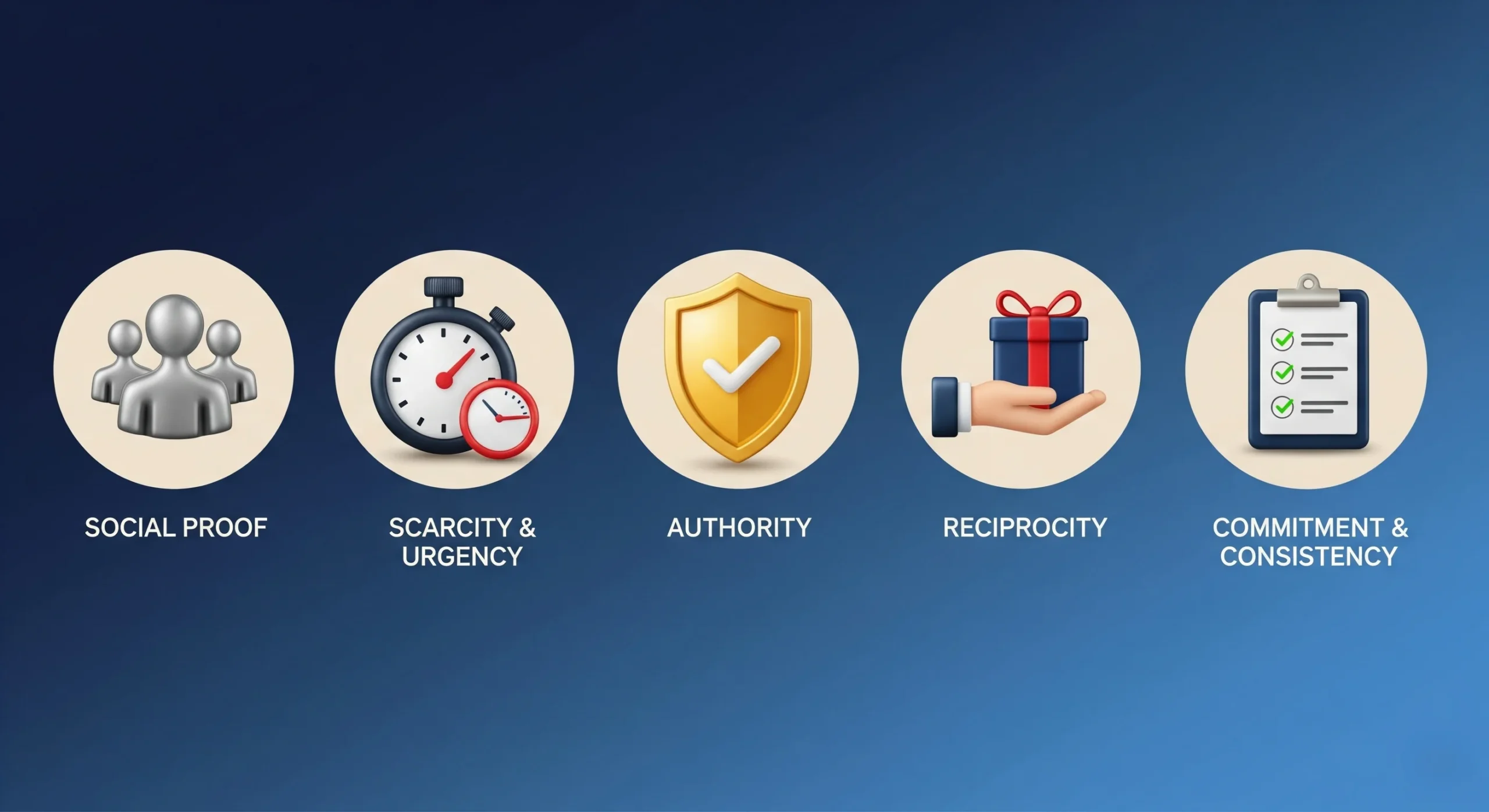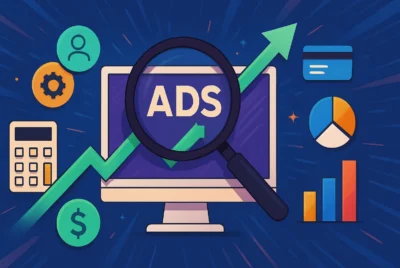Every day, your website greets thousands of visitors—yet only a fraction take the actions you want: subscribing, filling out a form, requesting a demo, or making a purchase. Traditional CRO tactics like A/B testing button colors or tweaking headlines can yield small gains, but to drive significant lifts in conversion rates, you need to tap into the underlying psychology of decision‑making.
In this deep dive, we unpack the five most powerful psychological triggers proven to influence behavior: Social Proof, Scarcity & Urgency, Authority, Reciprocity, and Commitment & Consistency. For each trigger, you’ll learn why it works, tactics you can implement, detailed examples, best practices, and common pitfalls. By the end of this guide, you’ll have a blueprint to transform your website into a conversion engine that not only looks great but speaks directly to visitors’ motivations, fears, and desires.
1. Social Proof: Harnessing the Herd Mentality
1.1 The Science Behind Social Proof
Coined by psychologist Robert Cialdini in his seminal work Influence, social proof describes our tendency to look to others when determining our own behavior—especially under uncertainty. When we see peers endorsing a product or service, we infer it must be valuable (and low‑risk). This herd mentality reduces cognitive load (“If thousands bought it, it must be good”) and mitigates anxiety.
1.2 Key Social Proof Tactics
- User Reviews & Ratings: ★★★★★ star ratings with reviewer photos; Sortable reviews by date, rating, or feature.
- Customer Logos & Case Studies: “Trusted by” strips featuring client logos; In‑depth case studies with quantifiable results.
- Media Mentions & Awards: “As featured in Forbes, TechCrunch, and The Wall Street Journal”; Industry awards and certifications.
- Live Counters & Real‑Time Stats: “123 people are viewing this right now”; “456 items sold in the last 24 hours”.
- User‑Generated Content (UGC): Instagram feeds or photo galleries of real customers; Social media testimonials embedded on product pages.
1.3 Before‑and‑After Example: E‑Commerce Site
Breakdown of Impact
- Emotional Comfort: Reviews and UGC alleviated fears about product quality and fit.
- Authority by Numbers: High user counts and badges signaled reliability.
- Real‑Time Activity: Live counters triggered FOMO, nudging cautious browsers to act quickly.
2. Scarcity & Urgency: Fueling the Fear of Missing Out
2.1 Why Scarcity and Urgency Work
Behavioral economics teaches that loss aversion—our tendency to prefer avoiding losses over acquiring equivalent gains—is stronger than our drive for gains. When something is scarce or time‑limited, we overvalue it, fearing regret if we miss out. Pairing scarcity (limited quantity) with urgency (limited time) creates a potent one‑two punch that compels action.
2.2 Effective Scarcity & Urgency Tactics
- Limited Stock Indicators: “Only 3 left in stock!” banners next to buy buttons; Dynamic stock counts using real‑time inventory data.
- Countdown Timers: Flash sale clocks on landing pages (“Sale ends in 02:15:23”); Timers in cart abandonment emails reminding users of expiring baskets
- Limited‑Time Promotions: “Today only: 25 percent off” alerts triggered on page load; Seasonal countdowns (e.g., “48 hours until end of Cyber Week”).
- Exclusive/Invitation‑Only Access: “Invite‑only presale for email subscribers”; “Limited VIP slots—apply now”.
- Dynamic Messaging: Geotargeted urgency: “Only 2 seats left for NYC workshop!”; Personalized timers based on user’s time zone.
2.3 Before‑and‑After Example: SaaS Pricing Page
Breakdown of Impact
- Scarcity Cue: Low seat counts on pricing tiers boosted perceived exclusivity.
- Urgency Trigger: Personal countdown timers created immediate incentive to upgrade.
- Synced Messaging: Website and email timers aligned, reinforcing urgency across channels.
3. Authority: Establishing Expert Credibility
3.1 The Psychology of Authority
We instinctively defer to experts and figures of authority, believing their recommendations are trustworthy and accurate. In marketing, showcasing credentials, endorsements, and certifications builds confidence, reduces perceived risk, and shortens the decision journey.
3.2 Proven Authority‑Building Tactics
- Expert Endorsements & Testimonials: Videos or quotes from well‑known industry figures; Guest contributions or interviews on your site.
- Certifications & Security Seals: SSL/TLS, PCI compliance, ISO certifications; Trust badges (e.g., “Norton Secured,” “McAfee Secure”).
- Media Features & Awards: “Featured in” logos of reputable publications; Industry awards (e.g., “Top 100 Startup 2025”).
- Founder & Team Bios: Credentials, years of experience, notable past roles; Professional headshots, links to LinkedIn profiles.
- Data‑Backed Claims: “Our platform reduces manual work by 60 percent” with accompanying data chart; Whitepapers and research studies hosted on your domain.
3.3 Before‑and‑After Example: B2B Service Landing Page
Breakdown of Impact
- Credibility Signals: Certifications and partner badges conveyed professionalism.
- Expert Alignment: Media features positioned the agency as a recognized thought leader.
- Data‑Driven Proof: Brief case study snippet gave tangible evidence of past success.
4. Reciprocity: The Power of Giving to Generate Returns
4.1 Understanding Reciprocity
As social psychologist Cialdini notes, when someone gives us something of value, we feel compelled to return the favor. In digital marketing, offering free resources—guides, tools, samples—builds goodwill and primes visitors to reciprocate by engaging further, subscribing, or purchasing.
4.2 High‑Impact Reciprocity Tactics
- Free Downloadable Resources: Ebooks, whitepapers, checklists, templates gated by an email form; “Ultimate SEO Checklist” or “Website Redesign Budget Template”
- Interactive Tools & Calculators: ROI calculators, mortgage calculators, audit tools (SEO health check); Personalized results emailed or displayed instantly
- Free Trials & Samples: Time‑limited product trials with no credit card required; Sample boxes for physical products or free consultations for services.
- Webinars & Workshops: Live training sessions with Q&A; On‑demand recordings gated by registration
- Exclusive Community Access: Invite‑only Slack or Facebook groups for buyers/subscribers; Early‑access product forums or beta testing programs
4.3 Before‑and‑After Example: Marketing Agency Website
Breakdown of Impact
- Immediate Value: Templates and tools offered tangible benefits upfront.
- Low Barrier: Requiring only an email address maximized form submissions.
- Ongoing Engagement: Automated follow‑up flows nurtured resource downloaders toward paid services.
5. Commitment & Consistency: Securing the Foot‑in‑the‑Door
5.1 The Principle of Consistency
Once people commit to something—especially publicly or in small steps—they strive to appear consistent with that commitment. This drive influences them to follow through on larger requests later. In CRO, starting with micro‑commitments (small, easy “yes” asks) paves the way for bigger conversions.
5.2 Commitment‑Building Tactics
-
Micro‑Commitment Questions
Initial “Yes/No” or “Quick poll” before revealing the main form: “Do you struggle with website conversions?”
Gamified quizzes (“Which marketer are you?”) that funnel into personalized recommendations. -
Multi‑Step Forms
Break long forms into 2–4 simple screens (“Step 1: Name,” “Step 2: Email,” “Step 3: Needs assessment”).
Show progress indicators (“Step 2 of 4”) to reinforce commitment. -
Preference Centers
Let subscribers choose the topics they care about (e.g., SEO tips, social media strategies, case studies).
Personalized email journeys based on preferences. -
Low‑Barrier Entry Offers
“Enter your email to view this quick tip video”.
“Sign up for our newsletter and get a 2‑minute conversion audit”. -
Public Declarations
Social sharing prompts after a micro‑commitment (“Share your quiz result on LinkedIn!”).
User testimonials or success stories highlighting small wins.
5.3 Before‑and‑After Example: B2B Lead‑Gen Page
Breakdown of Impact
- Reduced Friction: Splitting the form and starting with a micro‑commitment lowered perceived effort.
- Psychological Drive: Progress bars tapped into the desire to finish what was started.
- Enhanced Qualification: Early questions gathered valuable lead data without scaring users away.
6. Integrating and Layering Psychological Triggers
To maximize impact, don’t treat these triggers in isolation. Layering complementary tactics can create exponential lifts:
Best Practices for Layering:
- Map User Journeys: Identify touchpoints—landing pages, pop‑ups, email, chatbot—and decide which triggers fit best.
- Test One Change at a Time: Even when layering, use A/B tests to isolate the impact of each new element.
- Maintain Clarity: Don’t clutter pages with too many badges or timers; prioritize the highest‑impact triggers.
- Monitor Metric Shifts: Track micro‑conversions (clicks, scroll depth) in addition to macro‑conversions (purchases, signups).
- Iterate Rapidly: Based on performance data, swap in new social proof elements, adjust scarcity messaging, or refine micro‑commitments.
7. Measurement, Testing, and Optimization
A data‑driven approach ensures your psychology‑based tweaks actually move the needle.
7.1 Key Metrics to Track
- Macro Conversion Rate: Purchases, lead form submissions, trial signups
- Micro‑Conversion Rate: Clicks on social proof carousels, engagement with timers, completion of micro‑commitments
- Average Order Value (AOV): To detect upsell/cross‑sell impact
- Time on Page & Scroll Depth: Engagement proxies for content‑driven pages
- Drop‑Off Points: Use funnel analysis tools to find where visitors abandon
7.2 A/B and Multivariate Testing
- Single Variable Tests: Change only one element (e.g., add social proof badge) to measure its lift.
- Multivariate Tests: Test combinations of elements (badge + timer + testimonial) to find the best pairing.
- Split URL Tests: Direct traffic to entirely different page versions when you need radical layout changes.
7.3 Tools for Testing & Analytics
7.4 Continuous Optimization Cycle
- Hypothesize: Based on visitor behavior and psychology principles, propose a change.
- Implement: Develop test variants with clear naming conventions.
- Test: Run experiments until statistically significant results emerge.
- Analyze: Compare metrics, segment results by device, channel, and demographic.
- Roll Out or Refine: Deploy winning variation site‑wide or iterate further for incremental gains.
8. Common Pitfalls and How to Avoid Them
9. Case Study: Comprehensive Trigger Overhaul
9.1 Background
A mid‑market SaaS provider saw stagnant sign‑up rates (~2 percent) despite high traffic volumes. The site lacked credibility indicators, dynamic urgency, and guided micro‑commitments.
9.2 Strategy
- Added Social Proof: Customer logo strip + rotating user testimonials on homepage.
- Implemented Scarcity: Real‑time seat availability and timed promotional banners.
- Bolstered Authority: “G2 Leader” badge + founder’s Harvard case mention.
- Offered Free Resources: “Download our onboarding guide” in exchange for email.
- Streamlined Forms: Two‑step signup with progress bar and initial micro‑question.
9.3 Results (After 90 Days)
Key Takeaways
- Layering Triggers: Combined tactics created compounding conversion lift.
- Holistic Measurement: Tracking both engagement and signups revealed deeper behavioral shifts.
- Iterative Refinement: Ongoing A/B tests continued to identify micro‑improvements (e.g., testimonial placement tweaks).
10. Action Plan: Getting Started Today
- Audit Your Key Pages: Identify top 3–5 pages by traffic and current conversion performance.
- Select Initial Triggers: Pick one or two triggers (e.g., social proof on homepage, scarcity in checkout) to implement first.
- Design & Develop: Create assets: gather testimonials, build countdown scripts, design micro‑commitment forms.
- Test & Validate: Set up A/B tests, define success metrics, ensure proper tracking.
- Analyze & Roll Out: Once you see a statistically significant lift, deploy universally and move on to the next page or trigger.
- Document & Share: Maintain an internal playbook of successful implementations, test results, and creative assets for future reference.
Conclusion
Psychological triggers provide a competitive edge by speaking directly to core human motivations—our desire to belong, to avoid loss, to trust experts, to reciprocate kindness, and to stay consistent with our commitments. By thoughtfully applying social proof, scarcity & urgency, authority, reciprocity, and commitment & consistency, you can transform your website from a passive brochure into an active conversion engine.
Remember:
- Start small with one or two triggers and measure impact.
- Layer strategically for compounding effects.
- Test rigorously to distinguish real lifts from noise.
- Iterate continuously—even small optimizations add up over time.
Armed with these insights and examples, you’re ready to craft experiences that not only look great but drive real results.
Ready to supercharge your conversions?
At D’Digital, our CRO specialists blend behavioral science, data analytics, and creative execution to deliver sustainable conversion lifts. Contact us to schedule a conversion audit and begin your journey toward winning website performance.



